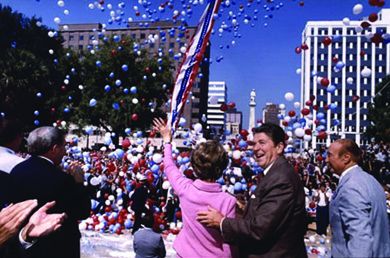| << Chapter < Page | Chapter >> Page > |
After two unsuccessful Republican primary bids in 1968 and 1976, Reagan won the presidency in 1980. His victory was the result of a combination of dissatisfaction with the presidential leadership of Gerald Ford and Jimmy Carter in the 1970s and the growth of the New Right . This group of conservative Americans included many very wealthy financial supporters and emerged in the wake of the social reforms and cultural changes of the 1960s and 1970s. Many were evangelical Christians, like those who joined Jerry Falwell’s Moral Majority, and opposed the legalization of abortion, the feminist movement, and sex education in public schools. Reagan also attracted people, often dubbed neoconservatives, who would not previously have voted for the same candidate as conservative Protestants did. Many were middle- and working-class people who resented the growth of federal and state governments, especially benefit programs, and the subsequent increase in taxes during the late 1960s and 1970s. They favored the tax revolts that swept the nation in the late 1970s under the leadership of predominantly older, white, middle-class Americans, which had succeeded in imposing radical reductions in local property and state income taxes.
Voter turnout reflected this new conservative swing, which not only swept Reagan into the White House but created a Republican majority in the Senate. Only 52 percent of eligible voters went to the polls in 1980, the lowest turnout for a presidential election since 1948. Those who did cast a ballot were older, whiter, and wealthier than those who did not vote ( [link] ). Strong support among white voters, those over forty-five years of age, and those with incomes over $50,000 proved crucial for Reagan’s victory.

Reagan’s primary goal upon taking office was to stimulate the sagging economy while simultaneously cutting both government programs and taxes. His economic policies, called Reaganomics by the press, were based on a theory called supply-side economics, about which many economists were skeptical. Influenced by economist Arthur Laffer of the University of Southern California, Reagan cut income taxes for those at the top of the economic ladder, which was supposed to motivate the rich to invest in businesses, factories, and the stock market in anticipation of high returns. According to Laffer’s argument, this would eventually translate into more jobs further down the socioeconomic ladder. Economic growth would also increase the total tax revenue—even at a lower tax rate. In other words, proponents of “trickle-down economics” promised to cut taxes and balance the budget at the same time. Reaganomics also included the deregulation of industry and higher interest rates to control inflation, but these initiatives preceded Reagan and were conceived in the Carter administration.

Notification Switch
Would you like to follow the 'U.s. history' conversation and receive update notifications?